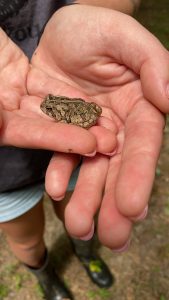The Maryland Coastal Bays Program hosted two volunteer surveys last month to assess the species diversity of reptiles and amphibians, or herps, in the area.

A small frog, or herp, is pictured in someone’s hand.
Photo courtesy Maryland Coastal Bays Program
By Tara Fischer, Staff Writer
The Maryland Coastal Bays Program hosted two volunteer surveys last month to assess the species diversity of reptiles and amphibians, or herps, in the designated areas.
The studies are vital in understanding the health of local ecosystems, Chesapeake Conservation and Climate Corps member Kelsey Poisal said. The group organized two explorations. The first was hosted at Ilia Fehrer Nature Preserve in Berlin and ran from 9 a.m. until noon. The second event was at Showell Nature Preserve, which lasted from 9:30 a.m. to 3:30 p.m.
The environmental program welcomed over 40 volunteers as they searched 28 plots, each 25 by 25 meters, across the two properties. Poisal said that the group found a combined total of 10 frogs, including a few tadpoles and eggs, 34 toads, 32 snakes, four turtles, and 34 salamanders.
“Herps are an integral part of the ecosystem, and amphibians are considered indicator species,” Poisal noted. “This means that their presence indicates that the environment is relatively healthy. Using data from herp surveys, you can track species’ presence over time and make inferences about how the ecosystem’s health may change. If, in the future, we notice that reptile and amphibian species presence declines, then we may want to consider habitat restoration options. Now that we know which species can be found in the coastal bays region, we can incorporate these species into future environmental education programs.”
Poisal said that amphibians are sensitive to pollution and environmental degradation. Therefore, their presence indicates a healthy ecosystem.
Additionally, herps serve as both prey and predator, balancing the ecosystem and providing necessary services to the health of the environment. These include seed dispersal, biological pest control and bioturbation, and they act as a protein source for other organisms.
Poisal said the initiative was created as the main component of her capstone project. As she is working for the Maryland Coastal Bays Program this year as a Chesapeake Conservation and Climate Corps member, she was to host an endeavor that fills a gap in the organization.
“MCBP used to have herp surveys about a decade ago,” she said. “I thought that bringing herps back into focus with these surveys would be a great addition to all of the programs MCBP uses to educate the public about our watershed.”
The study aimed to inform volunteers of the importance of reptiles and amphibians within an ecosystem. Poisal created a field guide about herps on Maryland’s coastal bays in preparation for the surveys. The PowerPoint, accessible on the organization’s official website, provides information on the various species on the Eastern Shore.
The Maryland Coastal Bays Program recently hosted an outreach program about diamondback terrapins and how to protect their nests.
“With a group of community volunteers, we built nest covers that can be placed over a terrapin nest to protect their eggs from predation,” Poisal said. “We currently have nest covers available at our office for anyone to come pick up, free of charge, if they have terrapins nesting on their property.”
